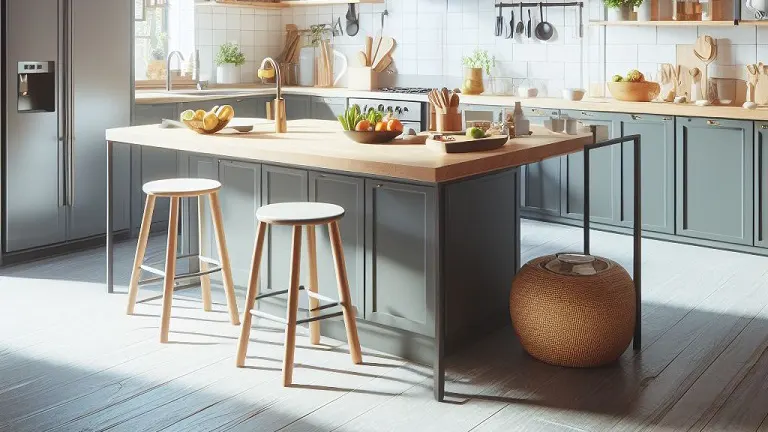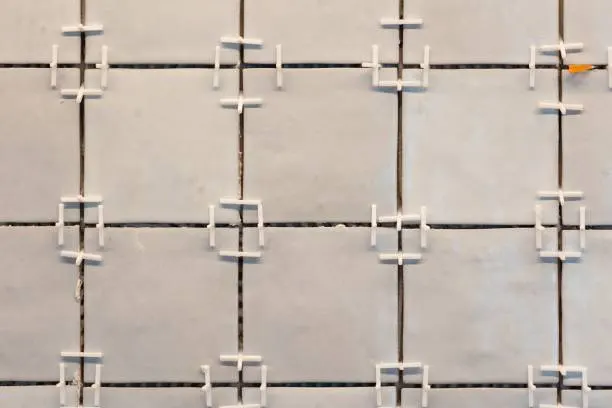
You can effortlessly shell out $20 to $30 per square foot on premium flooring for your kitchen. However, if you’re open to exploring options and handling the installation yourself, a fresh kitchen floor can cost significantly less than $1 per square foot. It’s crucial to remember that cost isn’t the sole factor. The material must also be suitable for the kitchen environment. Any valid option must fulfill two conditions:
DIY-Friendly
Real savings are only achievable if you can install the flooring yourself. If you need to outsource the installation, it won’t be an economical floor, even if the materials themselves are low-cost.
Durability and Ease of Cleaning
If you have to replace the flooring in a few years, either because it’s tarnished or deteriorating, it’s not a good deal.
The top four options that meet these guidelines for affordable kitchen flooring are ceramic tile, vinyl, laminate, and cork. That’s a relatively extensive list, considering that all of these materials come in a variety of styles. They all perform well in the kitchen.
The costs provided below are recent prices from a national home improvement retailer. They are subject to change and do not include underlayment, adhesive, grout, or other installation supplies. Keep these additional costs in mind when evaluating any flooring.
Also, consider the resale value while selecting flooring materials: An economical flooring option may not be the best choice if it diminishes the value of your home. It’s always a good idea to balance cost-effectiveness with potential return on investment.
Vinyl Flooring
Available in sheets, tiles, or luxury vinyl planks, vinyl flooring is the simplest kitchen flooring material to install. If your subfloor is in good condition, vinyl is also the most affordable because you can usually install it directly over the subfloor (or suitable existing flooring), avoiding the cost of new underlayment. Vinyl comes in several types, so you can shop based on price, appearance, and/or installation method. The most budget-friendly type of vinyl tends to be peel-and-stick tile, followed by peel-and-stick planks and sheet vinyl.
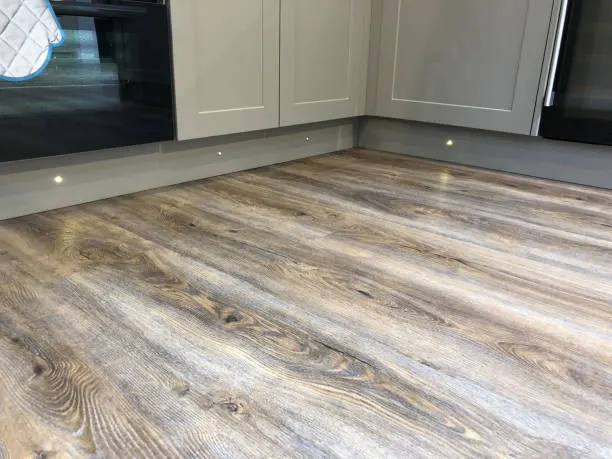
The best all-around DIY option is the luxury plank, which is usually thicker than standard vinyl tile and can be installed as a click-together floating floor.
Prices
Prices for high-quality vinyl flooring start at $.50 per square foot for economy vinyl sheets, and $1.50 to $2.00 per square foot for standard tiles; you will have literally hundreds of options. High-quality luxury vinyl planks start at about $3 per square foot, with many very attractive options available in the $3 to $4 range.
Advantages
Vinyl flooring is one of the best-performing materials for a kitchen floor, with several notable advantages:
- One of the most affordable of all flooring materials
- A resilient surface that is easy on the feet
- Very easy to clean with simple damp mopping
Disadvantages
Vinyl flooring has one main drawback:
- Vinyl can be gouged or scratched rather easily.
Installation Tips
For tiles: Dry-lay a full row across the width and length of the floor to establish a layout, then draw perpendicular layout lines to guide the installation.
For sheet vinyl: Create a perimeter template with butcher paper, and cut the flooring in one piece—a no-glue method (using double-sided tape in select areas) is easiest.
For luxury vinyl planks: Allow the planks to acclimate in the room for a full 48 hours before installation. Use layout lines to guide the installation.
Laminate Flooring
Laminate is one of the most sought-after inexpensive flooring materials, primarily because it can convincingly imitate a variety of more costly flooring materials. Laminate flooring can be designed to resemble hardwood, natural stone, or even slate.
Laminate flooring has a rightful place among economical kitchen flooring options, but it’s not the most durable choice for this room—despite the manufacturers’ claims. The hard resin surfaces of the planks are scratch- and stain-resistant enough to withstand kitchen traffic and abuse, but the seams between planks are susceptible to water damage. A leaky dishwasher or overlooked spill can cause the planks to swell along the edges, so you must be mindful of standing water, and avoid wet-mopping altogether (occasional damp-mopping is okay). If you’re willing to spend more, consider “water-resistant” laminate, which is guaranteed to resist standing water for a specified period (such as 24 hours).
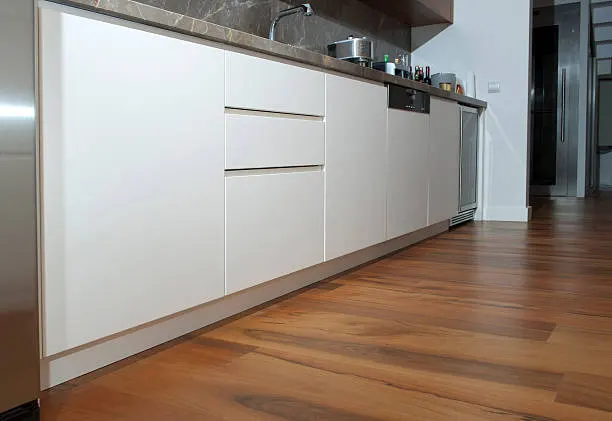
Prices
Prices for laminate flooring start at about $0.50 per square foot for standard flooring and about $2 per square foot for water-resistant laminate. Even top name brands rarely cost more than about $3 per square foot.
Advantages
Laminate flooring’s advantages include:
- Can convincingly mimic wood, ceramic tile, stone, and other premium floor coverings
- Surprisingly easy installation for DIYers
Disadvantages
For kitchens, laminate flooring does have some negatives to consider:
- Not ideal for areas where moisture is an issue
- Can be scratched
- Underlayment and trim pieces can add substantially to installation costs
- Should not be cleaned by wet-mopping
Installation Tips
Installing a laminate floating floor in the kitchen is a doable day-long project. Be very careful with the plank edges during installation; they break easily. Plan the plank layout so you don’t end up with a really short piece at either end of a row or a really narrow strip at either side of the room.
Ceramic Floor Tile
Ceramic tile gives you the most value for your money because you get a virtually indestructible surface that’s easy to clean—although the grout lines can be difficult to keep clean unless you seal them carefully. If properly installed, bargain tile lasts just as long as the most expensive tiles. Cheap tiles may be less trendy, but if you go for a clean, simple style, no one will be the wiser.
The biggest cost savings with ceramic tile is in the money you save from DIY installation. Professional tile work can cost as much as $14 per square foot.
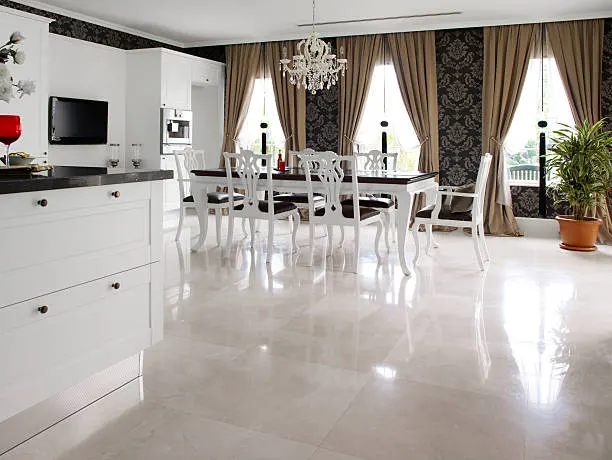
Prices
Prices for ceramic tile start at about $0.50 per square foot for plain solid-color tile, although there additional costs for underlayment, thin-set adhesive, and grout. Good-quality porcelain tiles that mimic the look of wood or natural stone begin at about $3 per square foot.
Advantages
Ceramic tile is a classic kitchen flooring material, with virtues that include:
- A very elegant flooring surface
- Extremely durable—can last for decades
- Surfaces are easy to clean
Disadvantages
Ceramic tile has some disadvantages when used in kitchens:
- A very hard surface that leads to fatigue; dropped dishes may shatter
- Can be a cold surface on the feet
- Grout joints are prone to trapping dirt and stains
- A more complicated installation than most other types of flooring
- Additional materials needed can significantly add to the overall cost
Installation Tips
Install the tile over a layer of cement board, which helps stiffen the floor (to prevent cracking) and isn’t affected by moisture that gets through the tile. Plan your layout carefully to ensure that the results are pleasing to the eye.
Cork Flooring
Cork is at the higher end of budget-friendly flooring options, but it’s a comfortable and visually appealing material that’s easy to install. It offers more cushion underfoot than the others and is quite durable. You might have to shop around to find cork as low as $3 per square foot, but it is available.
Cork is most commonly sold as snap-together planks or tiles for a floating floor installation, similar to how laminate flooring is installed. This makes cork a good DIY option, and many types of cork do not require the foam underlayment that is necessary with laminates, since the planks have a layer of built-in underlayment.
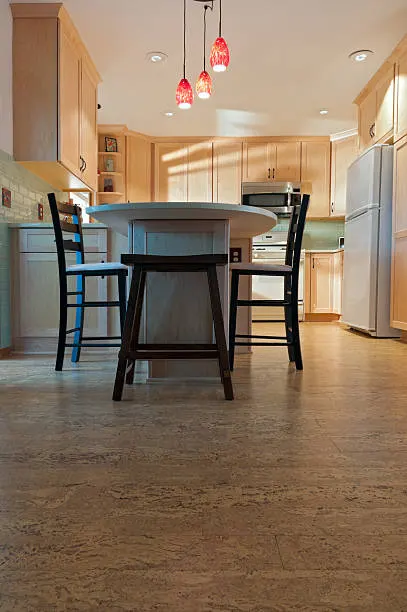
Prices
Cork flooring starts at about $3 per square foot for click-lock planks. The higher-end cork flooring products available at home centers cost about $8 per square foot.
Advantages
The advantages of cork flooring in a kitchen are few but very important:
- Very comfortable for the feet
- Easy installation
Disadvantages
Though they don’t outweigh the advantages, there are some drawbacks to cork flooring in a kitchen:
- A bit more expensive than other flooring options
- Not as durable as ceramic tile
- Can be damaged by high heels, sports cleats, and pet claws
Installation Tips
Plan the layout of the planks so you don’t end up with a really short piece at either end of a row or a really narrow strip at either side of the room.
Use a tapping block to hammer the pieces together and lock the joints. Hammering directly on the planks can break them.
Conclusion
In conclusion, when it comes to affordable kitchen flooring options, there are several materials that offer a balance between cost and durability. These include vinyl, laminate, ceramic tile, and cork. Each of these materials has its own set of advantages and disadvantages, and the best choice often depends on your specific needs and circumstances.
For instance, vinyl is the easiest to install and one of the most affordable, but it can be scratched easily. Laminate can convincingly mimic more expensive materials like hardwood and stone, but it’s not ideal for areas where moisture is an issue. Ceramic tile is extremely durable and easy to clean, but it can be a hard and cold surface underfoot. Cork is comfortable and easy to install, but it’s a bit more expensive than other options and can be damaged by high heels, sports cleats, and pet claws.
Ultimately, the best flooring option for your kitchen will depend on your budget, DIY skills, and the specific demands of your kitchen environment. It’s also important to consider the potential impact on the resale value of your home when choosing a flooring material. A cheap flooring option may not be the best choice if it lowers the value of your home. Therefore, it’s always a good idea to balance cost-effectiveness with potential return on investment. Remember, the right flooring can enhance the beauty and functionality of your kitchen while also adding value to your home.
FAQs
- What type of flooring is best for kitchen?
The best kitchen flooring depends on your lifestyle and budget. Hardwood floors offer a classic look and durability, while ceramic tiles are easy to clean and maintain. Vinyl and laminate flooring are also popular choices due to their affordability and variety of styles. - What is the current trend for kitchen floors?
The current trend for kitchen floors leans towards natural-looking materials. This includes hardwood flooring in various finishes, stone or stone-look tiles, and luxury vinyl that mimics natural materials. The use of bold patterns and colors is also on the rise. - What is the trend in kitchen flooring 2023?
In 2023, the trend in kitchen flooring is moving towards sustainable and eco-friendly materials like bamboo and cork. There’s also a growing preference for luxury vinyl tile (LVT) due to its durability and wide range of design options. - What’s the cheapest flooring for a kitchen?
The cheapest flooring options for a kitchen are typically vinyl or laminate. Both materials come in a variety of styles and colors, and they’re durable and easy to clean. - What is the safest kitchen flooring?
The safest kitchen flooring options are those that are slip-resistant and easy to clean. This includes textured ceramic tiles, vinyl flooring, and cork, which is naturally anti-microbial and resistant to mold and mildew. - What flooring makes a kitchen look bigger?
Light-colored flooring can make a kitchen look bigger and brighter. Large-format tiles or wide planks can also create the illusion of more space. - What is the most durable type of flooring?
The most durable types of flooring include ceramic tile, natural stone, and hardwood. These materials can withstand heavy traffic and are resistant to stains and damage. - What tiles are best for a kitchen floor?
Porcelain and ceramic tiles are often recommended for kitchen floors due to their durability and ease of maintenance. They’re also available in a wide range of styles and finishes, allowing you to customize the look of your kitchen. - What is the best color for a kitchen floor?
The best color for a kitchen floor depends on the overall design of your kitchen. However, neutral colors like beige, gray, and brown are versatile and can complement most color schemes. - Which is the healthiest flooring for homes?
The healthiest flooring for homes is typically natural and low-VOC materials like solid hardwood, cork, or bamboo. These materials don’t emit harmful chemicals and are easier on indoor air quality.
